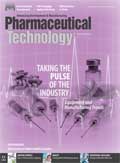The Potential of Perfusion
Potential for improved product quality and cost/time savings is reviving interest in perfusion technology.
Tuomas Kujansuu/E+/Getty Images

Perfusion technology was first introduced in the late 1980s to boost the low product concentrations obtained from the early cell lines used for biopharmaceutical manufacturing. Dramatic increases in titers for batch and fed-batch cell-culture processes over the next two decades largely eliminated the need for perfusion and interest waned. A key driver today is the production of unstable proteins that require low residence times in the bioreactor. Recently, however, rising cost pressures have been driving the need to achieve greater efficiency and productivity and reduce costs. Continuous bioprocessing is seen as a possible solution and, consequently, perfusion is once again attracting significant attention.
In perfusion mode, high cell numbers are sustained for much longer periods by constantly feeding fresh media and removing spent media while the cells remain in culture. With this approach, optimum conditions for growth and production are maintained by supplying the appropriate nutrients and removing toxic waste products. Because the product is also regularly removed and separated from the waste products that can cause degradation, perfusion is highly beneficial for biologic APIs that are unstable under production conditions.
Different methods are used to remove the spent cells, including centrifugation, in which the cells
are separated and then returned to the reactor; alternating tangential-flow (ATF) filtration, in which the cells remain in the reactor and the spent media and product are collected in the filtrate; and the use of adherent cells that bind to capillary fibers or membranes in the bioreactor, which allows easy separation from the spent media.
Introduction of the ATF technology (by Refine Technology; now owned by Repligen) was quite significant for perfusion processes, according to Parrish Galliher, CTO of Xcellerex, which is part of GE Healthcare’s Life Sciences business. “ATF and other filtration perfusion processes allow for complete clarification of the product, whereas with centrifugation, approximately 90% of the cells are recycled back to the bioreactor, and an additional filtration step is required to remove the remaining 10% of the cells from the product.” He also notes that advances in single-use technologies for perfusion have greatly simplified the process because sterilization and cleaning systems are no longer required, which in turn has made it much easier to set up and evaluate perfusion as a viable option for cell culture.
Perfusion in practice
As indicated above, perfusion cell culture has been used in the industry to produce biologics clinically and commercially for more than 25 years. Currently, a handful of companies manufacture biopharmaceutical drug substances using perfusion technology, largely because these products are not stable in the bioreactor and must be removed quickly to minimize degradation/modification, according to Galliher.
Many more companies are looking at perfusion at the process development and clinical scales, however. This interest goes beyond the desire to improve the product quality of sensitive biologics; perfusion has the potential to reduce the scale at which reactions can be performed and increase productivity through better equipment utilization. “With the recent growing interest in continuous bioprocessing, there is renewed interest from manufacturers, equipment vendors, and academics in evaluating and pursuing perfusion technology,” says Chris Hwang, senior director of late-stage process development at Genzyme.
Many potential benefits
Properly designed perfusion processes can significantly increase volumetric productivities (grams/L of bioreactor working volume per day) such that the bioreactor scale can be significantly reduced, which facilitates adoption of disposable technologies. The result is an increase in operational and capacity flexibility, reduced capital and operational costs, and increased speed (facility readiness and manufacturing operation), according to Hwang.
In addition, due to the measurable decrease in production scale, it is possible to develop and scale up processes to production scale in development labs using the same control/automation systems and eliminate process scale-up in manufacturing, which significantly decreases technology-transfer risks. Site-to-site transfer risks can also be reduced because perfusion processes can be used to produce any protein (stable or non-stable), which facilitates standardization.
Product quality is also important. In addition to minimizing the risks associated with product degradation/modification due to the reduced product residence time in the bioreactor compared with what occurs in a fed-batch system, perfusion processes can achieve steady-state product quality and simplify downstream operations, which all result in decreased heterogeneity and greater product consistency.
The jury is still out, however, on whether perfusion and continuous biomanufacturing can truly increase development speeds and decrease costs for products that do not have stability/degradation issues, according to Galliher. “Perfusion is very easy to achieve on the lab scale, but there are many reports of additional challenges to its use on the commercial scale.
Opinions vary widely among those who have been involved in implementing larger commercial perfusion processes, with some eager to use the technology again and others who are not,” Galliher says. The potential advantages are sufficiently significant, though, and many people are evaluating perfusion to determine its applicability for their biopharmaceutical processes.
Integration with downstream continuous processes
Integration of a perfusion bioreactor process with continuous downstream processes (integrated continuous biomanufacturing, or ICB) increases the advantages of perfusion, according to Hwang. “If all of the unit operations between the bioreactor and downstream purification are performed continuously, one can minimize hold times and eliminate many unit operations, and all of the downstream equipment can also be miniaturized and single-use technologies can be utilized. The application of appropriate process analytical technology (PAT) enables automation of the entire production process without operator intervention, except to ensure uninterrupted medium and buffer supply,” he explains.
Genzyme/Sanofi has successfully demonstrated at production scale the integration of a perfusion bioreactor with continuous capture for model enzymes and monoclonal antibodies with the products Cerezyme (imiglucerase for injection), Fabrazyme (agalsidase beta), and Myozyme (alglucosidase alfa). In addition, proof-of-concept of a fully continuous process (end-to-end) has also been demonstrated at the lab scale, according to Hwang.
Numerous considerations remain
Despite changing perceptions of perfusion and continuous processing, significant challenges do remain. Some are very practical issues. A lack of adequate sensor technology for the on-line direct evaluation of product quality parameters-protein folding, aggregation, glycosylation, oxidation, contamination, etc.-is a risk, according to Galliher. “Product quality at present can only be monitored indirectly on-line through determination of solution temperature, pH, conductivity, etc., and the product quality cannot be determined until it is sampled and analyzed.
As a result, more business risk is accumulating the longer a process is run, and that risk is compounded even further if perfusion is directly integrated with multiple continuous downstream processes that occur without product sampling and analysis,” he explains. Robust in-line product quality sensors will reduce this operational risk.
Process quality by design (QbD) and design-space studies can also be more complex, because the ability to maintain product quality over an extended period of time must be verified for a full production run, which can go on for weeks or months. These longer run times can extend development times, according to Parrish, because QbD screening and optimization experiments take longer. It is possible to reduce the number of process parameters that are investigated to keep the development time similar to that of a batch/batch-fed process, but that may lead to the development of a less robust process. The positive view that FDA has of continuous manufacturing presents an opportunity to evolve the guidelines for QbD studies when applied to continuous processing.
Unexpected costs can also reduce the positive impacts of perfusion. As an example, Galliher notes the benefit that a perfusion bioreactor can be scaled down by as much as 10-fold compared to a conventional bioreactor, enabling adoption of single-use technology with a smaller footprint and lower costs. Because the process is continuous, additional sterile-feed and sterile-harvest collection vessels are required to keep the process operating. “These additional vessels take up room and carry additional costs that must be considered when determining the overall benefits of continuous biomanufacturing,” Galliher observes. Concentrates of cell-growth media and buffers coupled with in-line dilution can reduce these additional costs. Hwang also notes that in an ICB process, many of these tanks would be eliminated.
Other challenges have more to do with perceptions and company culture. “For companies that have historically relied on batch upstream and downstream processes for protein production, moving to perfusion/continuous processes can be difficult due to management concern about implementing what are considered to be new technologies for the company, particularly with respect to the potential for increased risk and development times,” Hwang explains. There is also often a desire to fully utilize existing production capacity, and it can be very challenging to overcome the deeply entrenched batch technology mindset throughout an organization. For existing products, there are additional concerns about implementing continuous processes as part of lifecycle-management strategies with respect to product comparability.
To overcome these challenges, Hwang recommends that, to gain experience, companies invest resources and capital for the testing of continuous platforms that is de-coupled from product development. That way, risks can be minimized because a new platform won’t be considered ready for manufacturing until the expected process benefits can indeed be achieved.
Future improvements
Given the heightened interest in perfusion and continuous bioprocessing, it is not surprising that equipment and device manufacturers are working to develop improved solutions for perfusion processes. “Key goals are to make perfusion more robust, scalable, and easier to operate,” says Galliher. GE is looking at all aspects of the system, such as in-line dilution systems and improvements of the filtration process (prevention of clogging) to increase flow rates for larger-scale, single-use filtration systems.
Both Galliher and Hwang agree that the development of novel, robust PAT sensors for in-line monitoring of process performance and product attributes in real time will be crucial for the more widespread adoption of perfusion and other continuous bioprocesses on a commercial scale. For full integration into disposable platforms for protein production, pre-sterilized production-scale perfusion systems must also be developed, according to Hwang.
“FDA has been encouraging the industry to transition to continuous manufacturing (CM) since 2011 because the agency sees CM as a key enabler for modernizing pharmaceutical manufacturing. I anticipate that with the continued improvement of bioreactor cell densities and further increases in volumetric productivities, there will be growing interest in the use of perfusion technology for protein production,” says Hwang. “Coupled with the potential significant strategic advantages of ICB, I suspect that industry adoption will continue to increase and further fuel advancement of the intensification of perfusion and continuous bioprocesses,” he concludes.
Article DetailsPharmaceutical Technology
Vol. 39, No. 8
Page: 36–38
Citation:
When referring to this article, please cite it as C. Challener. “The Potential of Perfusion,” Pharmaceutical Technology 39 (8) 2015.

Pharmaceutical Tariffs Are Imminent: How Industry is Bracing for Impact
April 16th 2025On April 14, 2025, the Trump Administration launched a national security-driven investigation into pharmaceuticals, a move that will likely result in tariffs being placed on pharmaceutical drugs, ingredients, and other components that are imported from outside of the United States.
Drug Solutions Podcast: A Closer Look at mRNA in Oncology and Vaccines
April 30th 2024In this episode fo the Drug Solutions Podcast, etherna’s vice-president of Technology and Innovation, Stefaan De Koker, discusses the merits and challenges of using mRNA as the foundation for therapeutics in oncology as well as for vaccines.